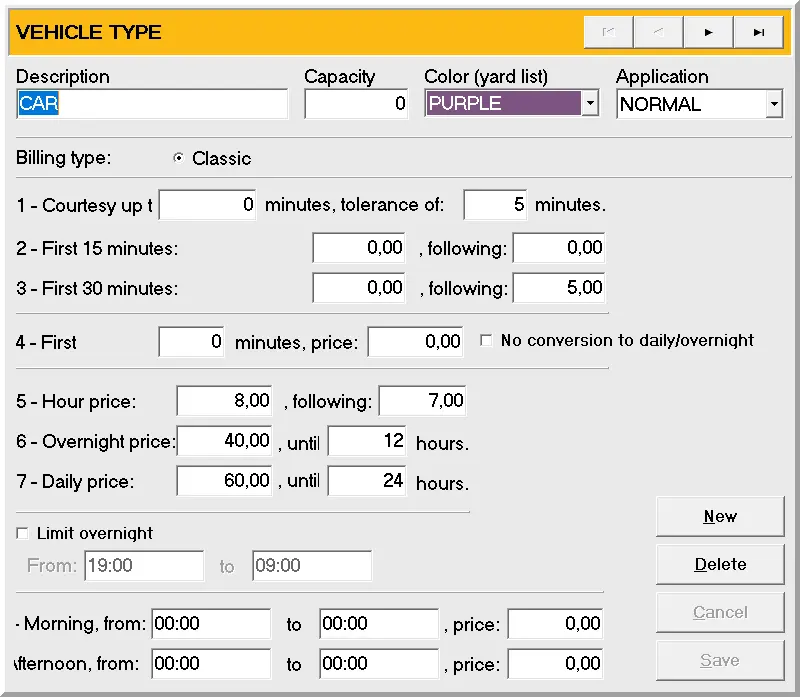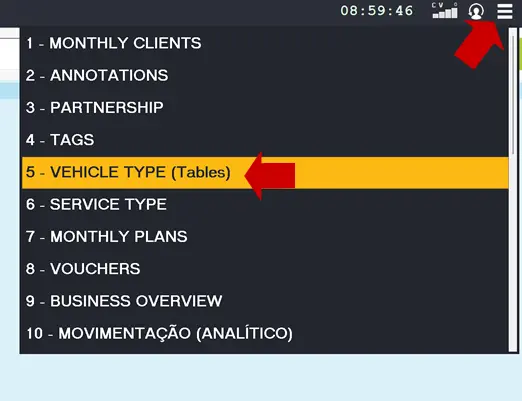How to Configure Parking Pricing Tables
Configuring pricing tables correctly in the PARKEER system ensures fair, accurate pricing adapted to the reality of your parking lot. In this guide you will learn how to create vehicle types (pricing tables), define parameters, apply fractions, daily rates, and overnight rates, as well as understand how the calculation flowchart works.
1. Accessing the Configuration Screen

- Login as Administrator
- Use the administrator account to unlock all configuration options.
- Open the software menu
- In the top right corner, open the Menu and select:
- Option 5 – Vehicle Types (Tables)
Tip: Each vehicle type can have its own pricing rule, allowing maximum flexibility.
2. Why Create Vehicle Types?
- Space usage: larger vehicles use more maneuvering area.
- Operational risk: larger vehicles require more care.
- Demand for spaces: tariffs help balance occupancy.
3. Creating a New Vehicle Type

Always click “Add” before configuring a new type, so you don’t overwrite existing tables (unless you intend to edit them).
Main fields:
- Description: Name to identify the table (e.g., Car, Pickup, Bicycle).
- Capacity: For internal statistics only, enter approximately the number of spaces available for that type of vehicle (doesn’t need to be exact).
- Color: The color that will appear for the record in the yard list, on the main (service) screen.
Application:
- Normal → The table appears at vehicle entry and can be selected as the customer’s vehicle type.
- Agreement → The table does not appear at entry; it is applied at exit (before entering the license plate) via the “Agreements” option. Ideal for changing the price entirely at checkout, such as granting special discounts, promotional rates, or corporate agreements.
4. Pricing Structure in PARKEER
The system organizes tariffs into 3 main blocks:
4.1 Fractions, Courtesy, and Tolerance
- Courtesy: free minutes upon entry (use only when necessary—be careful!).
- Tolerance: extra minutes after the fraction before charging the next one (to cover the difference between your parking clock and the customer’s watch).
- Fractions: pricing in intervals smaller than 1 hour (15 or 30 minutes).
⚠️ Courtesy, commonly used in shopping malls and commercial centers, can create opportunities for fraud if not well controlled. A dishonest employee could log vehicle entry, register the exit shortly after (within the courtesy period, without generating a charge), and when the customer returns to pay, collect the money manually and pocket it without reporting to the cashier. Therefore, only use courtesy when truly necessary and maintain strict controls to prevent such occurrences.
4.2 Hourly, Daily, and Overnight
- Hour: value of the first hour.
- Subsequent hours: value of hours after the first (2nd, 3rd, etc.).
- Daily: fixed price up to the stipulated number of hours.
- Overnight: tariff for a specific time range (e.g., 7 p.m.–6 a.m.) or for flexible hours.
Tip: Although the terms “daily” and “overnight” literally mean “day” and “night,” in parking they are borrowed from the hotel sector. Overnight does not necessarily mean “at night” but rather a partial stay (about 12 hours). Daily generally corresponds to a full 24-hour cycle regardless of starting time.
4.3 Special Settings
- Charging by shifts (morning/afternoon/night).
- Fixed tariffs for the first minutes.
5. Example Configuration – Bike
- Hour: R$ 1.50
- Subsequent hours: R$ 1.50
- Daily: R$ 7.50
- Fractions: not used
- Overnight: not used
Operation: Up to 5h → R$ 1.50 per hour. Once R$ 7.50 is reached, the system applies the daily rate up to 24h.
6. Example Configuration – Car
- Courtesy: 0 min
- Tolerance: 5 min
- Fractions (30 min): R$ 3.00 / R$ 2.00
- Hour: R$ 5.00 / R$ 5.00
- Overnight: 7 p.m.–6 a.m. / R$ 20.00
- Daily: R$ 35.00
Operation:
- Up to 35 min → R$ 3.00
- Up to 1h05 → R$ 5.00
- Up to 1h35 → R$ 7.00
- Afterwards → progressive sum until reaching daily or overnight.
7. Comparative Configuration Table
| Type | Color | Courtesy | Tolerance | 15/30 mins | Hourly Rate | Overnight | Daily |
| Bike | Orange | 5 min | Not applicable | $ 1,50 / $ 1,50 | Not applicable | $ 7,50 | |
| Light truck | Purple | 0 min | 5 min | $ 3,00 / $ 2,00 | $ 5,00 / $ 5,00 | 19h–6h / $ 20,00 | $ 35,00 |
| Car | Blue | 0 min | 5 min | $ 2,00 / $ 1,50 | $ 4,00 / $ 4,00 | 19h–6h / $ 15,00 | $ 28,00 |
8. Tariff Calculation Flowchart
ENTRY
↓
Vehicle enters the parking lot
↓
Select vehicle type (Car, Motorcycle, Pickup)
↓
Vehicle goes to the yard
EXIT
↓
Customer goes to cashier and presents vehicle ticket
↓
Using an agreement? (Yes → press F10 or click “Agreement” and select)
↓
Enter license plate or scan barcode
↓
System starts tariff calculation
↓
Courtesy? (Yes → ignore charge for courtesy minutes)
↓
Agreement by minutes? (Yes → subtract from initial charge)
↓
“First X minutes” configured? (Yes → apply value and minutes set)
↓
Fractions configured? (Yes → apply values for 15/30 minutes)
↓
Are fractions ≥ hourly value? (Yes → discard fractions, charge by hour)
SHIFTS
↓
Sum of fractions/hours within shift > shift value? (Yes → convert to shift)
OVERNIGHT
↓
Sum of fractions/hours within overnight period > overnight value? (Yes → convert to overnight)
DAILY
↓
Sum of fractions/hours/shifts/overnights within daily limit > daily value? (Yes → convert to daily)
System shows amount on screen with receipt:
- Customer pays exact amount (Yes → conclude)
- Enter cash received (e.g., 100) and system shows change
- ↓
- END
9. Best Practices
✅ Avoid courtesy unless truly necessary
✅ Always use tolerance of 3–5 minutes to avoid disputes
✅ Ensure consistency between fractions and hourly rate (e.g., if 30-min fractions sum to 7.00, first hour must also be 7.00)
Conclusion
By following these steps, your parking lot will be configured with optimized, fair, and secure tariffs, leveraging the full potential of PARKEER for smart management.
